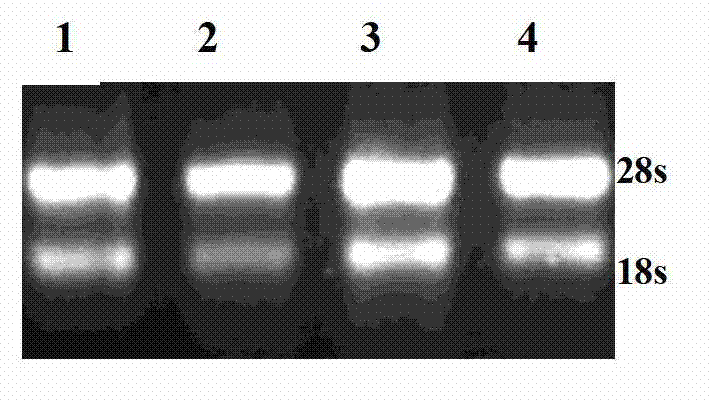Method and special primer for simultaneously detecting cherry whether to be infected by apple chlorotic leaf spot virus and prunus necrotic ringspot virus
A technology for ringspot virus and apples, applied in the field of simultaneously detecting whether cherries are infected with apple chlorotic leaf spot virus and Prunus necrotic ringspot virus and special primers, can solve the problems of being vulnerable to viruses, save time, and be easy to operate Effect
- Summary
- Abstract
- Description
- Claims
- Application Information
AI Technical Summary
Problems solved by technology
Method used
Image
Examples
Embodiment 1
[0045] The amplification of ACLSV and PNRSV virus in the blade of embodiment 1, ' red light '
[0046] Take 0.5 μl of 'Red Lantern' leaf RNA and detect it with a UV spectrophotometer, the OD260 / 280 is between 1.8-2.0 (Figure 1), and the cDNA after reverse transcription is used as a template. Through the PCR amplification of ACLSV and PNRSV viral primers AF1 / AR1 and PF / PR, 357bp and 455bp were obtained respectively ( figure 2 ) electrophoresis band, after gel cutting and recovery, connected to the T vector, transformed and sequenced by Escherichia coli DH5α, compared with the CP gene sequences of ACLSV and PNRSV registered on NCBI, the homology was 94% and PNRSV respectively. 98%. Therefore, the harvested 'Red Lantern' leaves are infected with both ACLSV and PNRSV, and the above-mentioned 'Red Lantern' leaves can be selected as a positive control.
Embodiment 2
[0047] Embodiment 2, establishment of multiple RT-PCR detection system
[0048] The leaves of 'Red Lantern' were used as experimental materials.
[0049] Annealing temperature selection: explore the annealing temperature of ACLSV virus primer AF2 / AR2 and PNRSV virus primer PF / PR, by image 3 It can be seen that the range of primer AF2 / AR2 is 45°C-57°C, and the annealing temperature of primer PF / PR is 45°C-60°C. In order to reduce the generation of primer dimers, we choose 57°C as the annealing temperature of the multiplex PCR reaction .
[0050] Only add ACLSV viral primer AF2 / AR2: only a single target band 632bp ( Figure 5 middle lane 1).
[0051] Only add PNRSV virus primer PF / PR: only get a single target band 455bp ( Figure 5 middle lane 4).
[0052] Adding primers AF1 / AR1 and PF / PR at the same time: no two target bands were obtained at the same time.
[0053] First add primer AF1 / AR1 and then add primer PF / PR: no two target bands were obtained at the same time.
...
Embodiment 3
[0059] Embodiment 3, sensitivity analysis
[0060] The total RNA amount of the 'red light' compound infected in the reverse transcription system, in order of 10 -1 、10 -2 、10 -3 、10 -4 、10 -5 、10 -6 、10 -7 μg, after PCR amplification, agarose gel electrophoresis, scanning gel imaging, to get Image 6 . As the total RNA concentration decreased, the template of ACLSV virus in the system also gradually decreased, resulting in the darker and darker target bands; while the target bands of PNRSV virus tended to become brighter first. It shows that increasing the concentration of the template can reduce the effect of the primer with strong template binding ability on the reaction. When the total RNA amount of the diseased plants in the reverse transcription system is 10 -4 At the time of μg, after PCR amplification, two viruses can still be detected at the same time.
PUM
 Login to View More
Login to View More Abstract
Description
Claims
Application Information
 Login to View More
Login to View More - R&D
- Intellectual Property
- Life Sciences
- Materials
- Tech Scout
- Unparalleled Data Quality
- Higher Quality Content
- 60% Fewer Hallucinations
Browse by: Latest US Patents, China's latest patents, Technical Efficacy Thesaurus, Application Domain, Technology Topic, Popular Technical Reports.
© 2025 PatSnap. All rights reserved.Legal|Privacy policy|Modern Slavery Act Transparency Statement|Sitemap|About US| Contact US: help@patsnap.com



